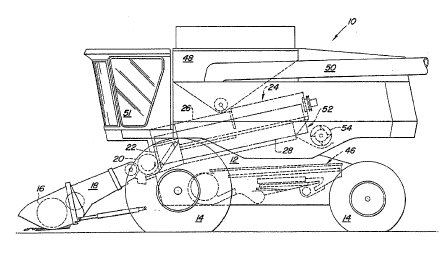Some of the information on this Web page has been provided by external sources. The Government of Canada is not responsible for the accuracy, reliability or currency of the information supplied by external sources. Users wishing to rely upon this information should consult directly with the source of the information. Content provided by external sources is not subject to official languages, privacy and accessibility requirements.
Any discrepancies in the text and image of the Claims and Abstract are due to differing posting times. Text of the Claims and Abstract are posted:
| (12) Patent: | (11) CA 2126486 |
|---|---|
| (54) English Title: | AXIAL FLOW COMBINE HAVING A CONCENTRIC THRESHING SECTION AND AN ECCENTRIC SEPARATING SECTION |
| (54) French Title: | MOISSONNEUSE-BATTEUSE A BATTEUR AXIAL CONCENTRIQUE, AVEC SEPARATEUR EXCENTRIQUE |
| Status: | Expired |
| (51) International Patent Classification (IPC): |
|
|---|---|
| (72) Inventors : |
|
| (73) Owners : |
|
| (71) Applicants : | |
| (74) Agent: | BORDEN LADNER GERVAIS LLP |
| (74) Associate agent: | |
| (45) Issued: | 1997-12-16 |
| (22) Filed Date: | 1994-06-22 |
| (41) Open to Public Inspection: | 1995-01-02 |
| Examination requested: | 1994-06-22 |
| Availability of licence: | N/A |
| (25) Language of filing: | English |
| Patent Cooperation Treaty (PCT): | No |
|---|
| (30) Application Priority Data: | ||||||
|---|---|---|---|---|---|---|
|
An axial agricultural combine having a single element
rotor defining a rotor axis. The rotor is housed in a rotor
housing having a threshing section and a separating section.
The threshing section of the rotor housing defines a threshing
axis and the separating section of the rotor housing defines a
separating axis. The threshing section of the rotor housing
is substantially concentric with the rotor axis passing
through that section. The separating section of the rotor
housing is arranged eccentric to the rotor axis. The
separating axis being located above the rotor axis.
Moissonneuse-batteuse axiale munie d'un rotor à un seul élément déterminant l'axe du rotor. Ce dernier est placé dans un boîtier de rotor comprenant une section de battage et une section de triage. La section de battage du boîtier du rotor définit un axe de battage et la section de triage un axe de triage. La section de battage de ce boîtier de rotor est sensiblement centrée sur l'axe du rotor traversant cette section. La section de triage de ce boîtier est décentrée par rapport à l'axe du rotor. L'axe de triage est, quant à lui, situé au-dessus de l'axe du rotor.
Note: Claims are shown in the official language in which they were submitted.
Note: Descriptions are shown in the official language in which they were submitted.

For a clearer understanding of the status of the application/patent presented on this page, the site Disclaimer , as well as the definitions for Patent , Administrative Status , Maintenance Fee and Payment History should be consulted.
| Title | Date |
|---|---|
| Forecasted Issue Date | 1997-12-16 |
| (22) Filed | 1994-06-22 |
| Examination Requested | 1994-06-22 |
| (41) Open to Public Inspection | 1995-01-02 |
| (45) Issued | 1997-12-16 |
| Expired | 2014-06-23 |
There is no abandonment history.
| Fee Type | Anniversary Year | Due Date | Amount Paid | Paid Date |
|---|---|---|---|---|
| Application Fee | $0.00 | 1994-06-22 | ||
| Registration of a document - section 124 | $0.00 | 1994-11-25 | ||
| Maintenance Fee - Application - New Act | 2 | 1996-06-24 | $100.00 | 1996-06-21 |
| Maintenance Fee - Application - New Act | 3 | 1997-06-23 | $100.00 | 1997-06-20 |
| Final Fee | $300.00 | 1997-07-24 | ||
| Maintenance Fee - Patent - New Act | 4 | 1998-06-22 | $100.00 | 1998-06-19 |
| Maintenance Fee - Patent - New Act | 5 | 1999-06-22 | $150.00 | 1999-06-21 |
| Maintenance Fee - Patent - New Act | 6 | 2000-06-22 | $150.00 | 2000-06-21 |
| Maintenance Fee - Patent - New Act | 7 | 2001-06-22 | $150.00 | 2001-06-21 |
| Maintenance Fee - Patent - New Act | 8 | 2002-06-25 | $150.00 | 2002-06-21 |
| Maintenance Fee - Patent - New Act | 9 | 2003-06-23 | $150.00 | 2003-06-20 |
| Maintenance Fee - Patent - New Act | 10 | 2004-06-22 | $250.00 | 2004-06-03 |
| Maintenance Fee - Patent - New Act | 11 | 2005-06-22 | $250.00 | 2005-06-03 |
| Maintenance Fee - Patent - New Act | 12 | 2006-06-22 | $250.00 | 2006-05-30 |
| Maintenance Fee - Patent - New Act | 13 | 2007-06-22 | $250.00 | 2007-05-30 |
| Maintenance Fee - Patent - New Act | 14 | 2008-06-23 | $250.00 | 2008-05-30 |
| Maintenance Fee - Patent - New Act | 15 | 2009-06-22 | $450.00 | 2009-06-01 |
| Maintenance Fee - Patent - New Act | 16 | 2010-06-22 | $450.00 | 2010-06-01 |
| Maintenance Fee - Patent - New Act | 17 | 2011-06-22 | $450.00 | 2011-05-31 |
| Maintenance Fee - Patent - New Act | 18 | 2012-06-22 | $450.00 | 2012-05-30 |
| Maintenance Fee - Patent - New Act | 19 | 2013-06-25 | $450.00 | 2013-05-30 |
Note: Records showing the ownership history in alphabetical order.
| Current Owners on Record |
|---|
| DEERE & COMPANY |
| Past Owners on Record |
|---|
| BRAUNHARDT, KLAUS ADAM |
| GERBER, MERLE RAY |
| STICKLER, MARK FREDRICK |